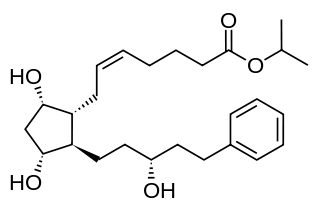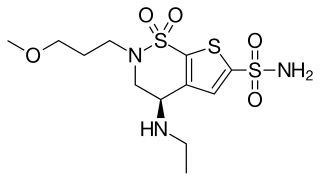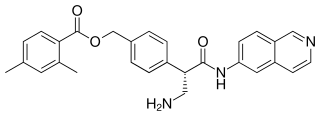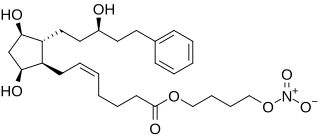Related Research Articles

Glaucoma is a group of eye diseases that lead to damage of the optic nerve, which transmits visual information from the eye to the brain. Glaucoma may cause vision loss if left untreated. It has been called the "silent thief of sight" because the loss of vision usually occurs slowly over a long period of time. A major risk factor for glaucoma is increased pressure within the eye, known as intraocular pressure (IOP). It is associated with old age, a family history of glaucoma, and certain medical conditions or medications. The word glaucoma comes from the Ancient Greek word γλαυκóς, meaning 'gleaming, blue-green, gray'.

Intraocular pressure (IOP) is the fluid pressure inside the eye. Tonometry is the method eye care professionals use to determine this. IOP is an important aspect in the evaluation of patients at risk of glaucoma. Most tonometers are calibrated to measure pressure in millimeters of mercury (mmHg).

Latanoprost, sold under the brand name Xalatan among others, is a medication used to treat increased pressure inside the eye. This includes ocular hypertension and open-angle glaucoma. Latanaprost is applied as eye drops to the eyes. Onset of effects is usually within four hours, and they last for up to a day.

Timolol is a beta blocker medication used either by mouth or as eye drops. As eye drops it is used to treat increased pressure inside the eye such as in ocular hypertension and glaucoma. By mouth it is used for high blood pressure, chest pain due to insufficient blood flow to the heart, to prevent further complications after a heart attack, and to prevent migraines.
Ocular hypertension is the presence of elevated fluid pressure inside the eye, usually with no optic nerve damage or visual field loss.

Brimonidine is an α2 agonist medication used to treat open-angle glaucoma, ocular hypertension, and rosacea. In rosacea it improves the redness. It is used as eye drops or applied to the skin.

Brinzolamide is a carbonic anhydrase inhibitor used to lower intraocular pressure in patients with open-angle glaucoma or ocular hypertension.

Bimatoprost, sold under the brand name Lumigan among others, is a medication used to treat high pressure inside the eye including glaucoma. Specifically it is used for open angle glaucoma when other agents are not sufficient. It may also be used to increase the size of the eyelashes. It is used as an eye drop and effects generally occur within four hours.

Travoprost, sold under the brand name Travatan among others, is a medication used to treat high pressure inside the eye including glaucoma. Specifically it is used for open angle glaucoma when other agents are not sufficient. It is used as an eye drop. Effects generally occur within two hours.

Levobetaxolol is a drug used to lower the pressure in the eye in treating conditions such as glaucoma. It is marketed as a 0.25 or 0.5% ophthalmic solution of levobetaxolol hydrochloride under the trade name Betaxon. Levobetaxolol is a beta-adrenergic receptor inhibitor.

Nicox S.A. is a French ophthalmology company developing treatments to maintain vision and improve ocular health. Nicox is headquartered in Sophia Antipolis, France, and its Chairman and CEO is Michele Garufi.
Brimonidine/timolol, sold under the brand name Combigan among others, is a fixed-dose combination medication eye drop used for the treatment of glaucoma. It is a combination of brimonidine and timolol.

Tafluprost is a prostaglandin analogue. It is used topically to control the progression of open-angle glaucoma and in the management of ocular hypertension, alone or in combination with other medication. It reduces intraocular pressure by increasing the outflow of aqueous fluid from the eyes.

Primary juvenile glaucoma is a subtype of primary congenital glaucoma that develops due to ocular hypertension and is diagnosed between three years of age and early adulthood. It is caused due to abnormalities in the anterior chamber angle development that obstruct aqueous outflow in the absence of systemic anomalies or other ocular malformation.
Ripasudil, a derivative of fasudil, is a rho kinase inhibitor drug used for the treatment of glaucoma and ocular hypertension.

Netarsudil, sold under the brand name Rhopressa among others, is a medication for the treatment of glaucoma. In the United States, in December 2017, the Food and Drug Administration (FDA) approved a 0.02% ophthalmic solution for the lowering of elevated intraocular pressure in people with open-angle glaucoma or ocular hypertension. The European Medicines Agency approved it in 2019 for the same uses under the brand name Rhokiinsa.

Latanoprostene bunod is an ophthalmic drug approved in the United States in 2017 for the reduction of intraocular pressure in patients with open-angle glaucoma or ocular hypertension. It targets the trabecular meshwork directly.
Bimatoprost/timolol, sold under the brand name Ganfort, is a medication for the treatment of certain conditions involving high pressure in the eyes, specifically open angle glaucoma and ocular hypertension. It is available as eye drops.
Brinzolamide/brimonidine, sold under the brand name Simbrinza, is a fixed-dose combination medication used to reduce intra-ocular pressure in adults with ocular hypertension or in those with an eye condition known as open-angle glaucoma. It contains brinzolamide and brimonidine tartrate. It is used as an eye drop.

Omidenepag, sold under the brand name Eybelis among others, is a medication used for the treatment of glaucoma and ocular hypertension.
References
- 1 2 3 4 5 "Rocklatan- netarsudil and latanoprost ophthalmic solution, 0.02%/0.005% solution/ drops". DailyMed. 10 March 2020. Retrieved 2 June 2020.
- 1 2 3 4 5 6 7 "Roclanda EPAR". European Medicines Agency (EMA). 9 November 2020. Retrieved 22 January 2021. Text was copied from this source which is © European Medicines Agency. Reproduction is authorized provided the source is acknowledged.
- ↑ "Roclanda Product information". Union Register of medicinal products. Retrieved 3 March 2023.
- ↑ "Drug Approval Package: Rocklatan Ophthalmic Solution". U.S. Food and Drug Administration (FDA). 20 November 2019. Retrieved 2 June 2020.